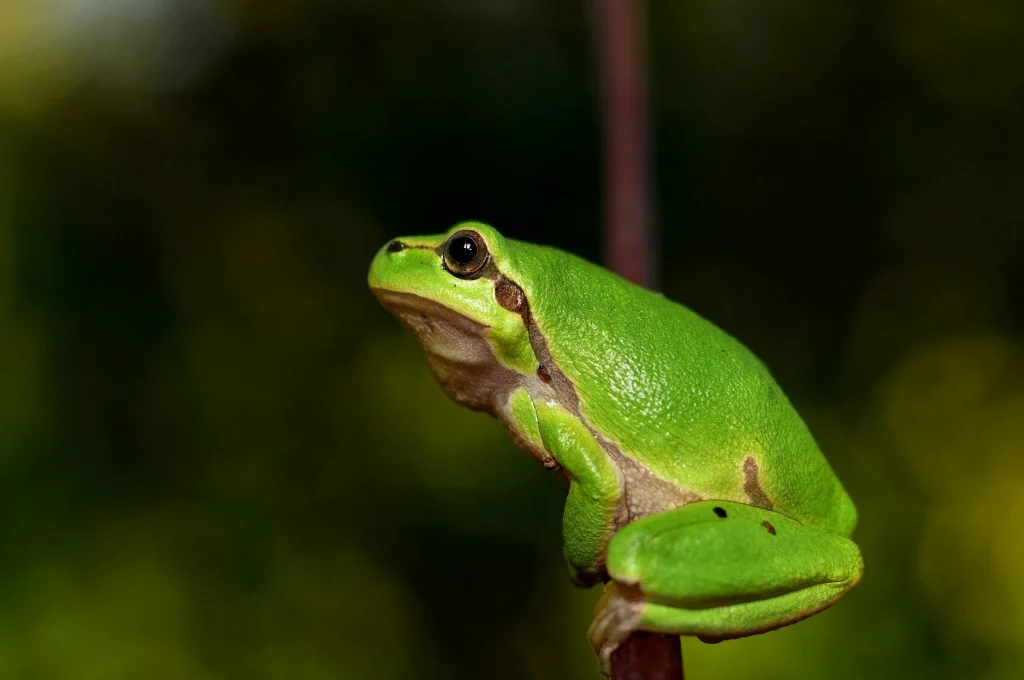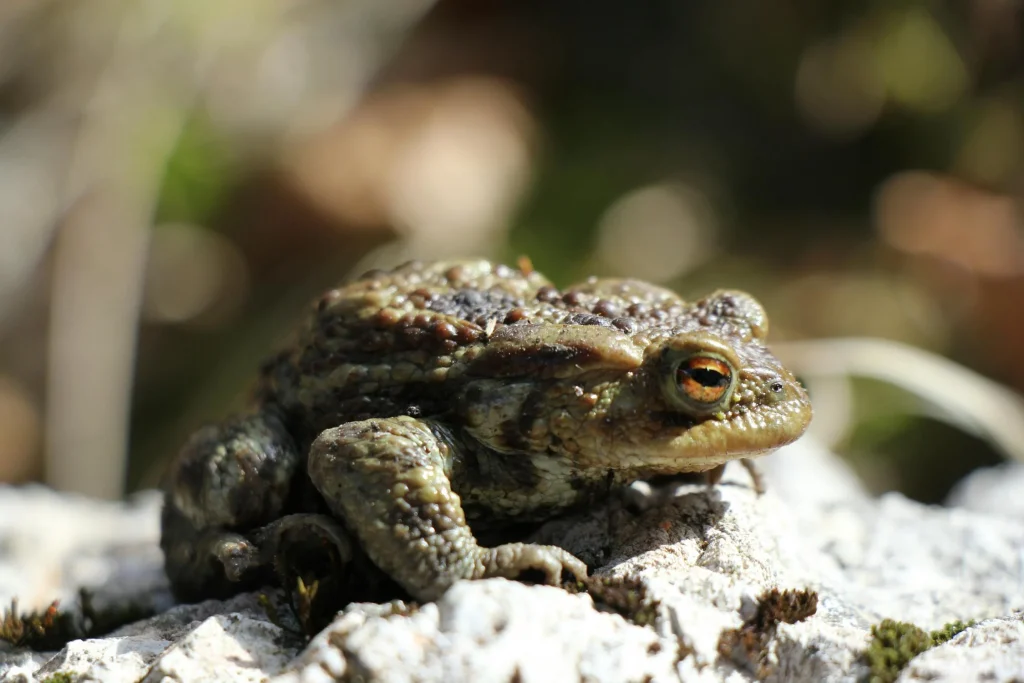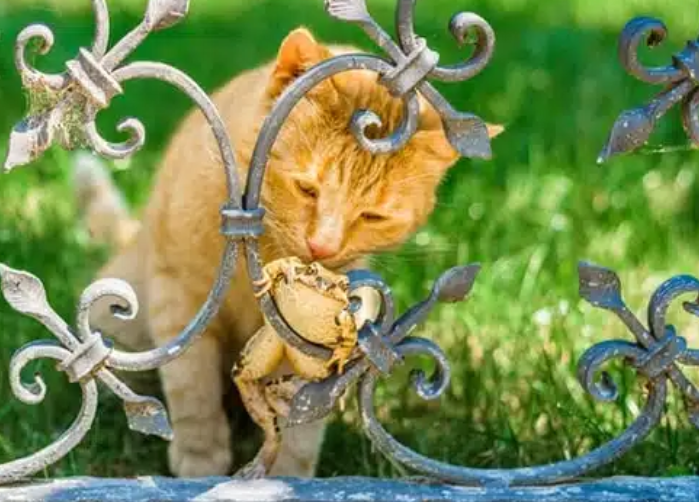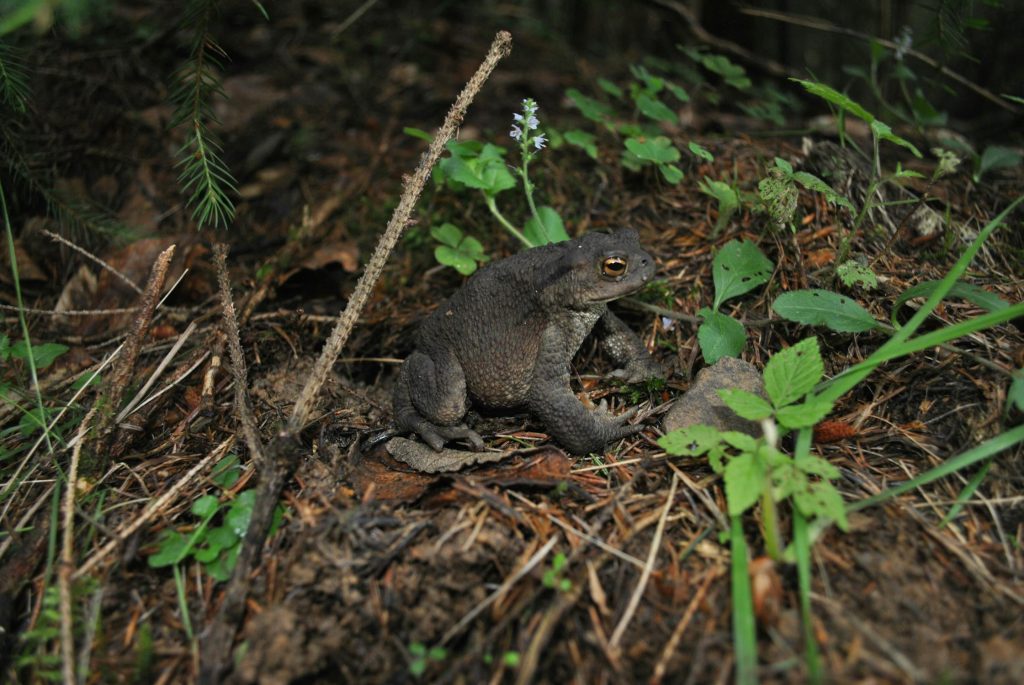Can Cats eat Frogs
Yes, cats can generally eat most frogs safely. Frogs are natural prey for cats, and in many cases, consuming a frog won’t cause harm beyond potential mild digestive upset. However, some frogs can be toxic or poisonous, particularly in tropical regions.

Expanding on this, it’s important to note that while cats can eat frogs, it doesn’t mean they should be encouraged to do so. Wild frogs may carry parasites or diseases that could be harmful to cats.
Additionally, cats’ hunting instincts often lead them to play with frogs rather than eat them. Domestic cats with access to regular meals are less likely to consume frogs than their wild counterparts. If you’re concerned about your cat’s frog-eating habits, consult with a veterinarian for specific advice tailored to your local area and your cat’s health needs.
Can Cats Eat Toads?
While cats can eat some frogs safely, toads pose a much greater risk. Many toad species secrete toxic substances through their skin glands, which can be harmful or even fatal to cats if ingested. In the United States, two particularly dangerous species are the cane toad (found in Florida, Texas, Hawaii, and Louisiana) and the Colorado River/Sonoran Desert toad (found in California, New Mexico, Arizona, and Texas).
Even licking these toads can cause severe poisoning in cats, leading to symptoms such as vomiting, diarrhea, heart abnormalities, and neurological issues.

It’s crucial for cat owners to be aware of the toad species in their area and take precautions to prevent their pets from coming into contact with them. If you believe your cat has encountered a toad, seek veterinary care immediately.
What causes toad poisoning?
Toad poisoning in cats occurs when they come into contact with toxic substances secreted by certain toad species. These toxins are produced in glands on the toad’s skin and are released as a defense mechanism when the toad feels threatened. The poisoning happens when a cat licks or ingests a toad, or even when it drinks water from a source where toads have been present.
The toxins can be absorbed through the cat’s mouth, open wounds, or other mucous membranes, quickly entering the bloodstream and affecting various body systems. Toads are poisonous at all stages of their life cycle, including as tadpoles and eggs. The severity of the poisoning depends on the toad species and the amount of toxin absorbed.

Cane toads and Colorado River/Sonoran Desert toads are particularly dangerous in North America. These large toads produce potent toxins that can cause severe symptoms and even death in cats if not treated promptly. The risk of toad poisoning is higher during the rainy season (typically March to September) when toads are more active and breeding.
Encounters are more likely to occur after rainfall or during dawn, dusk, and nighttime when toads are most active.
Clinical Signs of Toad Poisoning
- Drooling
- Frothing at the mouth
- Red gums
- Pawing at the mouth
- Vocalizing pain
- Vomiting
- Diarrhea
- Stumbling
- Tremors
- Seizures
- Abnormal eye movements
- Difficulty breathing
- Increased heart rate
- Decreased heart rate
- Abnormal heart rhythms
How is toad poisoning diagnosed?
Diagnosing toad poisoning in cats typically relies on a combination of factors. If your cat exhibits symptoms like excessive drooling, vomiting, weakness, difficulty breathing, or seizures, and you know or believe they may have come into contact with a toad, that’s a strong indication of poisoning. There isn’t a single definitive test, but your veterinarian may recommend bloodwork, chest/abdominal x-rays, and an ECG to assess the severity of the poisoning and determine the best course of supportive treatment.
Here are some additional tests that might be helpful, depending on the situation:
- Blood tests to evaluate electrolyte levels and organ function
- Chest x-rays to look for signs of fluid buildup in the lungs
- Abdominal x-rays to check for any abnormalities in the digestive system
- ECG to assess heart rhythm and function
What is the outlook for toad poisoning?
The prognosis for cats with toad poisoning varies depending on several factors, including the species of toad involved, the geographic location of the exposure, and how quickly treatment is initiated. With prompt decontamination and appropriate veterinary care, many cats can recover from toad poisoning.

However, in areas with highly toxic species like Florida, the outlook can be more guarded, and death may occur without immediate intervention. If a cat survives the initial poisoning episode, there are typically no long-term effects, and a full recovery is possible with proper treatment.
Which frog is toxic to cats
- Poison Dart Frogs (found in Central and South American rainforests)
- Golden Poison Frog (a specific type of Poison Dart Frog)
- Fire-Bellied Toads (found in parts of Asia and Europe)
- Cane Toads (found in Florida, Texas, Hawaii, and Louisiana in the US)
- Colorado River/Sonoran Desert Toads (found in California, New Mexico, Arizona, and Texas in the US)
What Are the Signs My Cat Has Eaten a Frog?
If your cat has eaten a frog, you may observe various signs depending on whether the frog was toxic. Common symptoms include excessive drooling or foaming at the mouth, which can occur even with non-toxic frogs due to the frog’s unpleasant taste. Your cat may paw at its mouth or show signs of discomfort.
Vomiting and diarrhea are possible, especially if the frog was toxic or carried parasites. In more severe cases of poisoning, you might notice difficulty breathing, irregular heartbeat, seizures, or disorientation. Some cats may become lethargic or show a lack of coordination.
If the frog was non-toxic, symptoms might be mild or absent. However, if you imagine your cat has eaten a toxic frog or toad, seek veterinary care immediately.
Nutritional Benefits of Eating Frog
- Source of protein, vitamins, and minerals for wild cats
- Provides lean protein, essential amino acids, and omega-3 fatty acids
- Contains vitamin B12
- Source of minerals like iron and zinc
What about Wild frogs for cats
While your domestic frog might not be a huge deal as a kitty snack, wild frogs are a whole different story. Many wild frogs, even if they aren’t poisonous themselves, can be crawling with nasty parasites or even diseases that could make your cat sick. On top of that, some frogs in tropical areas are downright toxic! For our pampered house cats, encountering any wild frog is a risk best avoided.

If you live in an area with these wild amphibians hopping around, it’s wise to keep a close eye on your feline friend when they’re outside. Discouraging any frog-hunting behavior is important for their safety. After all, there are plenty of fun, safe toys that can satisfy your cat’s natural hunting instincts without the risk of a froggy encounter.
What to Do if Your Cat Eats a Frog
Stay calm if you discover your cat chomped down on a frog. The first thing to do is take a deep breath and assess the situation. If you can figure out what kind of frog it was, that info can be a big help to your vet. Luckily, most garden-variety frogs aren’t likely to cause any serious harm. In that case, just keep an eye on your kitty for any signs of indigestion, like throwing up, diarrhea, or a bit of a tummy ache.
However, be ready to spring into action if your cat shows signs of a bad allergic reaction or has trouble breathing. If there’s even a chance the frog might have been poisonous, err on the side of caution and get your cat to the vet right away. This is especially important if it happens outside of regular vet hours.
How to Prevent Your Cat From Eating Frogs
Since curious cats love exploring the outdoors, keeping a close eye on them is your best bet. You can also make your yard a little less attractive to frogs by getting rid of any puddles or areas with standing water and keeping the grass nice and short. Motion-activated sprinklers can be a fun way to scare off both cats and frogs who might be considering a visit.
Inside the house, provide your feline friend with plenty of stimulating activities to keep their hunting instincts happy. Think interactive toys that mimic prey and climbing structures that let them channel their inner explorer.

Final Thoughts
Cats can technically eat frogs, but it’s a gamble. Most frogs are fine, offering a protein snack. However, some harbor toxins, especially in the tropics. If you’re unsure about the frog, best to err on the side of caution and avoid it altogether.
Read Also


